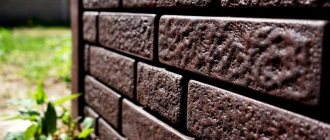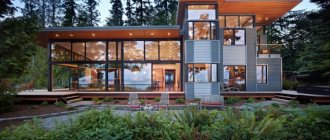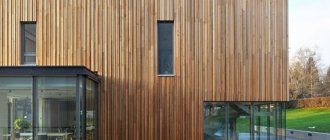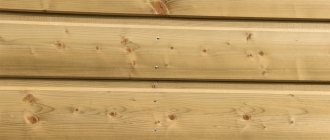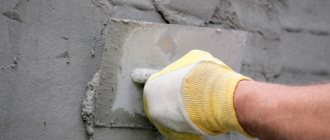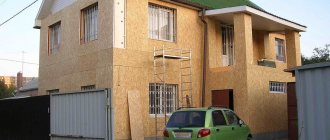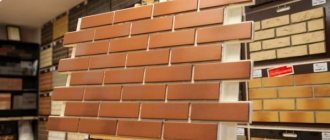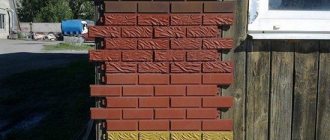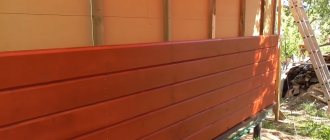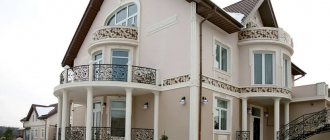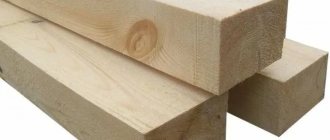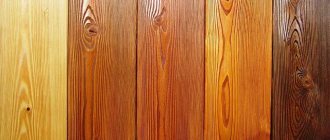Why does a house need cladding? It is needed to protect the wall material from frost, heat, and atmospheric phenomena. Siding for the exterior of a house is one of the most common materials that copes well with this task. It can be wooden, plastic, metal. Which to choose? Let's look at the characteristics of siding, its types, advantages and disadvantages.
Siding is one of the most popular types of finishing in Russia. (photo No. 1)
In the Russian climate, a house must either be built with very thick walls or additionally insulated. In the second case, the insulation can be installed from the inside or outside.
With internal insulation, the facade (if it is made of high-quality moisture- and frost-resistant material) can be left without cladding. But the usable area of the house will become much smaller, and in general this method is much less effective.
With external insulation, even a beautiful brick house needs additional exterior finishing to cover the insulation itself. A ventilated façade would be a win-win option in this case. This is a design that provides for a ventilation gap between the wall and the exterior finish. Air circulates freely in this space, which prevents moisture stagnation and the formation of mold and mildew.
One of the most popular types of ventilated facades is siding. These are wall panels made of different materials that differ in shape, color, texture and performance characteristics.
Types of siding for exterior home decoration
The number of materials from which siding is made is increasing. Today used:
- ➠ wooden,
- ➠ wood fiber,
- ➠ metal (steel or aluminum),
- ➠ plastic (vinyl and acrylic, as well as polypropylene panels),
- ➠ fiber cement,
- ➠ ceramic siding.
The most common among them, as before, remain wooden, metal and plastic panels.
Fiber cement siding is also gaining popularity, although, as a relatively new material, it remains quite expensive. !
The most common panels are wood, metal and plastic.
The characteristics of siding are determined by the properties of the materials from which it is made. Let's take a closer look.
Wood siding for exterior home decoration
Wooden siding. (photo No. 2)
Siding as a practical finishing material was first used in America. It was made of wood back then. The panels were mounted at an angle to the facade so that water would flow to the ground without getting on the walls. This installation method was called “herringbone”. Nowadays, wood siding is used less and less, despite the fact that it is the most environmentally friendly option. But he is demanding in care:
- It is important that installation takes place under appropriate conditions. It is not recommended to do this in frost and high humidity - otherwise the wood may subsequently become deformed.
- You need to prepare the material correctly. If the moisture level of the wood is higher than normal, the panels may crack or become covered with dark spots when drying.
- Wood must be treated to protect it from moisture, mold and pests. The first time is during installation, and then every 2-3 years.
- Wood burns easily. Therefore, the facade must be treated with special compounds for fire safety.
!
Wooden siding must be treated with protective agents: against moisture, pests and for fire safety.
Wood siding also has advantages:
- provides good thermal insulation,
- quiet: the rain will not drum on the facade, causing headaches for household members.
- looks beautiful - as a rule, it retains the natural color and texture of wood.
A few words about material burnout
Indeed, the question of whether siding, even the best quality, fades is often asked by owners of private houses. And yes, siding does become lighter when exposed to sunlight. People often consider this to be the main drawback of the material, however, before judging the quality of the finish based on this indicator, you should understand how siding burns out.
Siding Burnout
High-quality siding always fades gradually and evenly; this process is invisible to the eye. The difference will be noticeable only if you build an extension to a house covered with siding a few years later and cover it with exactly the same siding. The first one will be several shades lighter. That is why it is recommended to immediately sheathe the entire structure, and not to stretch this process over 1-2 seasons.
Siding walls
On a note! High-quality siding produced in Canada will begin to fade no earlier than 10 years after the start of use, material from Russian manufacturers will be as bright as the day of purchase for 5 years, and cheap, low-quality material will lose its richness of colors within a couple of years.
Why does siding fade differently? It's all about titanium dioxide, which is used in the siding production process. It’s just that much more of this substance is used in the manufacture of high-quality material.
Another example of using low-quality siding
Now it's time to figure out what types of siding exist. This will help you make the right choice of finishing material.
Metal siding for exterior decoration of the house
For façade cladding, panels are made of steel or aluminum. The second option preserves the metal surface without imitating other materials. As a rule, it is used in commercial architecture. It is not used in private housing construction because it is expensive and impractical.
Aluminum siding. (photo No. 3)
Steel siding is coated with a protective polymer layer to prevent corrosion.
Advantages of metal siding:
- ➠ It is durable - stronger than wood or plastic.
- ➠ Does not light. Although in fairness it should be noted that the polymer coating will melt and, if cheap materials were used, may release toxic substances.
- ➠ Not damaged by temperature changes.
- ➠ Can be installed all year round, in any weather - even in rain and snow.
- ➠ Rich range of colors and textures.
It is worth considering that metal has a high coefficient of thermal expansion. The panels should not be tightened during installation, otherwise the façade will be deformed due to temperature changes.
Metal siding (steel with a protective coating). (photo No. 4)
Disadvantages of metal panels:
- ➠ Metal is a conductor of heat. In hot weather, the façade will heat up significantly more than any other material.
- ➠ It will not protect the house from temperature changes, and this can negatively affect wall structures.
- ➠ Metal also has low noise insulation. The sound of rain and hail, any noise in the house will echo. Although a high-quality polymer coating will soften the effect a little.
- ➠ If the polymer coating is damaged, corrosion will occur. And the facade may need to be replaced.
- ➠ The impact causes dents in the metal. It will not be possible to align them, just leave them as is or replace the entire facade.
!
The walls of a house lined with metal siding will overheat in hot weather and overcool in winter. Therefore, they must be insulated.
Metal siding of budget categories is similar to corrugated sheeting and does not look very respectable. More expensive options allow you to choose a design with virtually no restrictions.
Useful recommendations when choosing
Knowing the main features of siding, the advantages and disadvantages of its varieties, you can make the right choice of facing material.
But in order for the siding finish to meet all expectations, arm yourself with some tips:
- vinyl siding has a high coefficient of expansion, so that this material does not burst in frost, installation of vinyl siding should be carried out only by professionals;
- wooden siding, despite all its environmental friendliness, will not last you very long, even with high-quality care;
- metal can rust, and after even a minor impact a visible dent may appear on its surface;
- if the house is located in a shaded area, you can use vinyl siding, but for a building that is constantly exposed to sunlight, it is better to use acrylic;
- for cladding, take siding from a trusted manufacturer with quality certificates; cheaper material can come in different sizes in one batch, which will bring additional difficulties during installation;
- if the walls of the house are uneven, they can be sheathed with any type of siding, but it is better to first arrange the sheathing;
- siding panels of a darker, more saturated color increase the cost of the material due to the presence of a large number of coloring pigments in the composition.
Fiber cement siding: panels for exterior home decoration
Fiber cement siding (photo No. 5)
Fiber siding is produced on the basis of cement and cellulose fibers. It is hard and strong like cement, but durable and not crumbly thanks to the fibers.
Fiber cement cladding has many advantages:
- ➠ Does not light.
- ➠ Does not rot or corrode.
- ➠ Resistant to water and moisture.
- ➠ Not destroyed by temperature changes.
- ➠ Does not crack or form dents even under strong mechanical stress.
- ➠ Looks aesthetically pleasing and has an impressive range of colors and textures.
- ➠ Does not crack or form dents even under strong mechanical stress.
However, it also has disadvantages:
- ➠ Fiber cement is heavy, so it is not suitable for all homes.
- ➠ It is quite expensive.
- ➠ When working with panels, you must strictly observe safety precautions. The cutting process generates dust that is hazardous to health.
!
Fiber cement siding is durable and reliable, but heavy, so it is not suitable for all homes.
Fiber cement siding can have almost any appearance: imitate wood panels, stone, tile, brick.
Advantages and disadvantages
There are a lot of positive characteristics of siding material, the main ones are:
- the period during which siding can be used without problems reaches 50 years;
- Thanks to the finishing with siding panels, the house acquires an attractive appearance . Using this material it is possible to create a variety of styles and realize the most daring design ideas;
- the material does not require special care, there is no need to paint it. It is very easy to handle;
- siding is characterized by lightness and elasticity;
- the process of installing panels is very simple, it requires the efforts of only one person, which allows you to significantly save on a team of workers;
- has high resistance to sudden changes in temperature;
- creates a reliable protective barrier for the surface of the facade of a house finished with siding from the effects of negative destructive environmental phenomena;
- condensation does not form under the surface of the panels, since there are ventilation holes in it that remove accumulated moisture;
- the material is resistant to rotting and corrosion processes, and is also not destroyed due to the activity of insects and microorganisms.
As for the disadvantages of this material, it is worth considering the following points:
- The material from which siding is made is completely synthetic. Accordingly, it does not have a sufficient level of environmental friendliness . This does not apply to the wooden variety of panels, although it is not as reliable as the others.
- Flammability of siding . This point is important in the event of a fire. If the panel begins to melt from the fire, then it releases caustic and toxic substances that are dangerous to the health of people and animals. Stewing products is very difficult.
- If low temperatures persist for a long time, the siding panels become very fragile and may begin to crack . It is even possible for parts of the panel to break off.
- The material is not very resistant to mechanical damage . This is especially important for the metal variety, since for it even a scratch on the surface is a significant threat to quality. The panels cannot be restored, which requires the cost of replacing a damaged panel.
PLEASE NOTE! For homes that are exposed to sunlight more often, it is best to choose light-colored siding as it is less susceptible to fading.
Plastic facade siding for exterior decoration of the house
There are two types of plastic siding: vinyl and acrylic. The first is made from PVC with the addition of additives that improve its properties.
Vinyl siding. (photo No. 6)
Acrylic siding differs in composition and appearance: special ASA polymers give it a glossy shine. Such panels are more resistant to heat and UV radiation, so they do not fade in the sun. Vinyl, on the contrary, have increased resistance to low temperatures.
The peculiarity of plastic siding is its susceptibility to thermal expansion and contraction. If the panels are installed correctly, with the necessary technological gaps, then such an expansion is completely harmless and will not harm the integrity of the facade. But if the installation technology is broken, the siding may become deformed due to temperature changes.
Acrylic siding. (photo No. 7)
Advantages of plastic siding:
- ➠ It's lightweight. Can even be used on frame buildings.
- ➠ Does not rot or rust.
- ➠ Not afraid of moisture and water.
- ➠ Does not support combustion. Without exposure to a direct fire source, the panels themselves extinguish.
- ➠ Does not require maintenance - just wash with running water from a hose.
- ➠ Does not deform due to changes in temperature and humidity.
- ➠ Easy to cut. This does not require special equipment; you can use ordinary home tools.
!
Plastic siding is the lightest of these. It is easy to cut and install. It is suitable for any house, even frame or old.
Cons of plastic siding:
- ➠ This is not a natural material.
- ➠ Low-quality panels can release toxic substances when burned.
A variety of shapes, colors and textures allows everyone to find their own option. Most often, plastic siding for the exterior of a house imitates a wooden facade. But panels with the texture of stone and brick are also made from plastic. In this case, a different technology is used, and the panels have a different shape, so we will put them in a separate group.
What it is?
Siding refers to the external part of the finishing of curtain-type facades (they are called ventilated).
In appearance, siding consists of long strips (panels) with perforations along the edges and latched locks. Using latches, the panels are assembled into separate sections of the required shape and size.
Siding is a word of English origin and translated means “external cladding,” which precisely determines the specifics of the use of such material.
Siding panels come in several types:
- Privates . Classic siding, also called basic.
- Auxiliary . They have their own gradation and are connecting, finishing and initial.
- Soffits . Ceiling-type siding panels are mainly used for roof cladding.
- Siding strips designed for finishing openings of door and window structures.
- Edging or corner , created for fastening the corner and end parts of panels.
Modern manufacturers offer a large number of siding colors for sale. The material also differs in texture. The wealth of choice of this modern material allows you to refine and insulate a private home, realizing any design ideas.
Expert opinion
Levin Dmitry Konstantinovich
According to statistics, the most popular siding is imitation natural wood (cladding, block house and timber), brick and plaster.
Basement siding under brick and stone for exterior decoration of the house
Facade panels (basement siding) imitating stone or brick were originally intended for cladding the base of a building. Here the finish is more often threatened by mechanical damage, so it is important to strengthen its strength. But thanks to its excellent aesthetic qualities, the entire façade began to be covered with basement siding.
Facade panels (basement siding) under the stone. (photo No. 8)
Facade panels are made not from PVC, but from polypropylene. This is the most durable type of plastic. Additional reinforcement is provided by stiffening ribs. Advantages of basement siding:
- ➠ Durability
- ➠ Durability
- ➠ Moisture resistance.
- ➠ Resistance to fungus, mold, corrosion.
Basement siding repeats the shape and texture of stone and brick, and so realistically that good panels cannot be distinguished from natural material from a few steps. But, unlike stone and brick, they can be installed quickly, at any time of the year, and even without experience.
!
Facade panels are stronger than plastic siding, but also more expensive.
Cons of basement siding:
- ➠ Unnatural material.
- ➠ Less durable than stone and brick.
There are many varieties of facade panels: siding for the exterior of a house to look like stone, like brick, like facade tiles, etc.
Wood siding for exterior home decoration: types
Foam siding "Alta-Board" (photo No. 9)
Today, wood siding is produced in three forms:
- ➠ shiplap (traditional type for vinyl and metal siding);
- ➠ “herringbone” (most often these are wooden or foamed polymer panels);
- ➠ blockhouse (imitation of a log house facade; can also be metal or plastic).
The choice in this case depends solely on your preferences. The shape does not affect the performance properties. For example, plastic panels such as shipboard and blockhouse do not differ from each other in quality and method of care.
